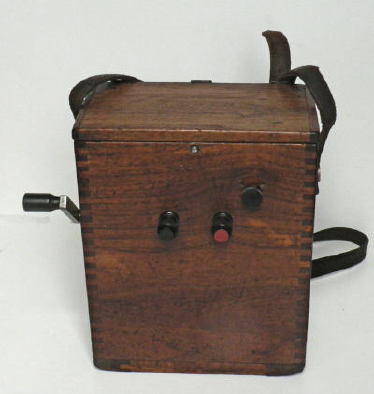
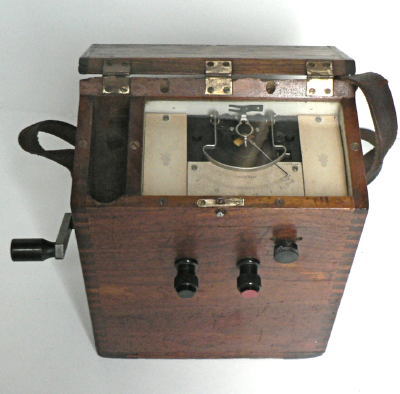
(Voigt & Haeffner or Union Electric )
Serial number 450941


This "Union Electric" insulation tester was in a very grubby
condition when I purchased it on Ebay for £10. The terminals were
incomplete and two of the internal resistors were open circuit. The
generator was in excellent condition and as can be seen from the
picture was well made and housed in a well designed and constructed
mahogany box with dovetail joints, the lid has a bevelled edge on the
hinge side so that it can be folded flat against the rear of the box.
The terminals and the black knob to the right of them are
replacements.To the left of the meter is a small compartment to stow
the generator handle when not in use.
Unlike other insulation testers that I have, this one is intended to be
operated whilst hanging from the operator's neck, the right hand
turning the generator handle and the left depressing the button to
unclamp the meter needle. I soon discovered that the brass shaft for
this knob is energised when the handle is turned!
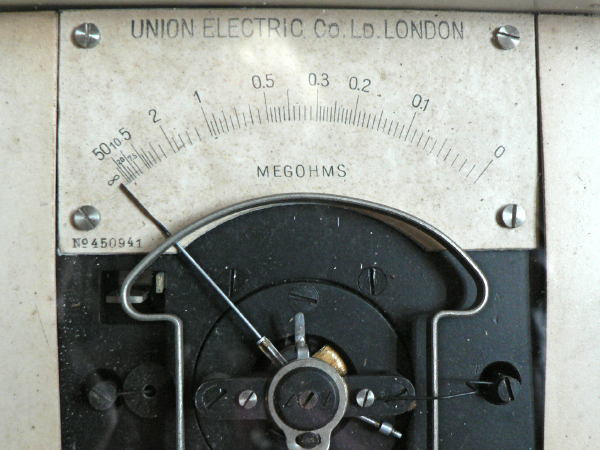
This is a close up view of the meter and the unusual mushroom shaped
pivoting mechanism surrounding the meter movement. At the left hand
side of the mechanism can be seen a small horizontal and a similar
vertical metal plunger. The former is operated by the push button knob
adjacent to the output terminals and serves to unclamp the meter
needle. The other is operated by an internal lever which serves the
same purpose but will permanently lift the clamp and render the push
button knob ineffective but as can be seen from the instructions (see
below) this lever should automatically operate once the correct reading
has been obtained and clamp the pointer. This should occur when the
speed governor fly weights swing outwards.
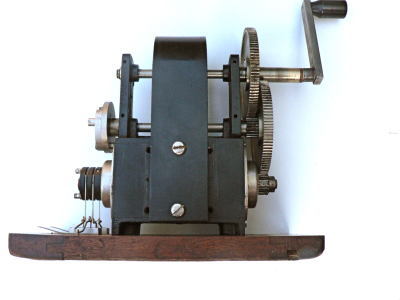
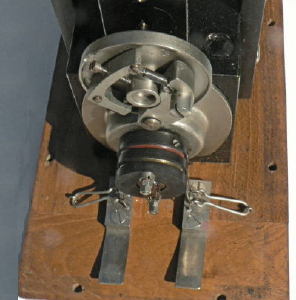
Here are two views of the generator showing the steel gearing, the commutator and the centrifugal governor. Note how the unit is completely self contained and equipped with contacts which mate with those on the remainder of the unit shown on the picture below.
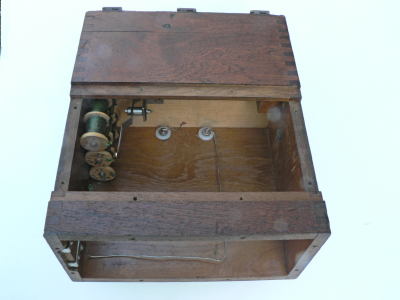
The series resistor is made up of three banks of three wire wound
wooden spools. Two of the banks are labelled 335,000w. As two of these
banks were open circuit I have left these in place but shunted them
with three high stability resistors totalling 335 000 ohms. The lever
for unclamping the meter can be seen to the right of the resistor
spools.
The meter has a full scale deflection of 1.5mA and a resistance of 215
ohms.
NSTRUCTIONS
The following have been
transcribed from a poor a very poor contion instrument owned by
Christopher King:
In order to obtain accurate results the following directions should be
carefully observed:
The circuits to be tested must not be connected to any other source of
pressure.
One terminal of the instrument is to be connected to the circuit under
test, the other terminal to earth.
Commence by turning the magneto slowly and steadily (about 50
revolutions of the crank per minute), this speed should be continued
for 30 seconds, afterwards gradually increase speed until the small
trigger under the automatic stop flies out and releases it, thus
locking the pointer. The indication is direct in megohms.
After each test, press the button. on the front side of the case to
reset pointer.
The screw on the back of instrument serves for correcting the zero
position of pointer.
The inductor must he greased periodically with’ some drops: of good
oil, and the collector with a drop. of petroleum, For this purpose:
remove the 8 screws from the wall of the apparatus. When the board has
been taken off the oil holes become visible.
The Union Electric Company Ltd. was until the outbreak of
World War One a subsidiary of Voigt and Haeffner which had a factory in
Frankfurt, where they made electrical apparatus they also had works in
Birmingham. The name then changed to " The Switchgear Construction
Company, Ltd." which incorporated both the British based firms. The
majority shareholders were still German. The Union Electric Company
installed electric lighting in the public galleries of the Natural
History Museum in London as well as lighting for London theatres.
I guessed that this instrument was made in Germany prior to 1914, the
trade mark device on the card either side of the meter scale is H&B
which indicates that it was made by Hartmann & Braun, also of
Frankfurt.

The Institute for Urban History in Frankfurt a.M. is in possession of the Hartmann & Braun company archive, including a number of books listing the scale numbers of their instruments from 1889 until 1959. The database which can be accessed here: https://www.alte-messtechnik.de/hub/skalennummer.php confirms my initial belief by indicating that it was most probably made in October 1913

